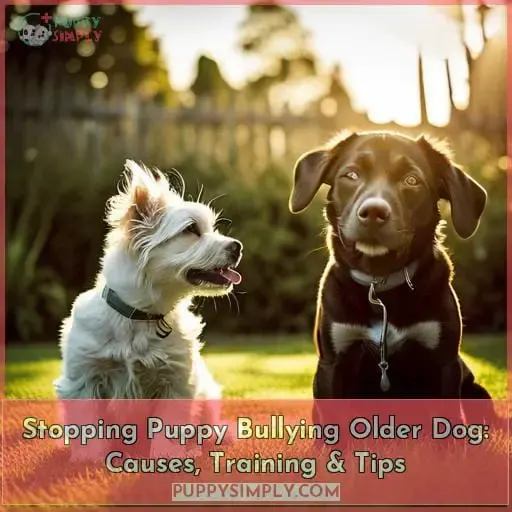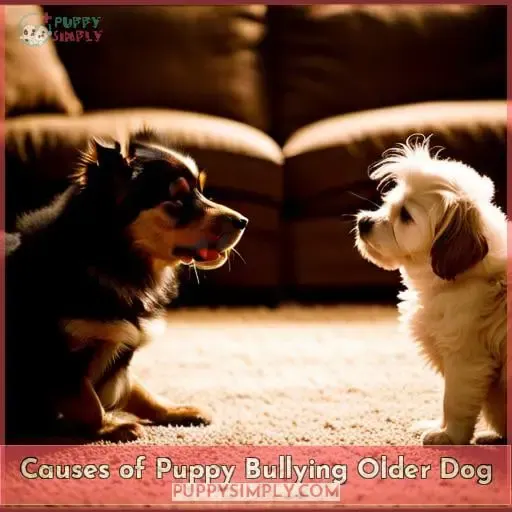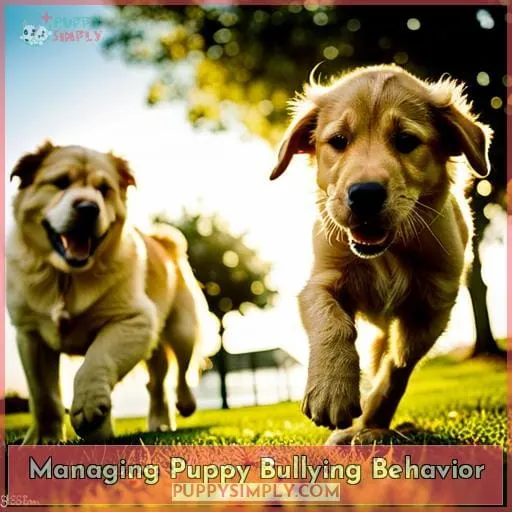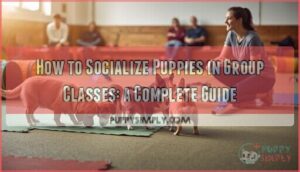This site is supported by our readers. We may earn a commission, at no cost to you, if you purchase through links.

While a puppy can sometimes dominate an older dog, you can manage this behavior by setting clear boundaries, providing proper exercise, and training the puppy. Establish yourself as the pack leader, redirect the puppy’s energy with toys and treats, and give the older dog a quiet retreat.
By taking these steps, you can create a peaceful environment for both canine companions.
Table Of Contents
Key Takeaways
- Puppy bullying older dogs is a common issue faced by pet owners.
- Causes of puppy bullying include medical issues, aggression, resource guarding, rough play, and lack of socialization.
- Dominance theory has been largely debunked.
- Establishing clear boundaries and expectations is important.
Causes of Puppy Bullying Older Dog
Introducing a discussion on puppy bullying older dogs, it is important to consider potential causes such as medical issues, aggression, resource guarding, rough play, and lack of socialization. All of these factors can contribute to an unhealthy relationship between the two pets and should be addressed with patience and care.
It is essential for pet owners to recognize any signs of bullying or aggressive behavior from either animal in order to provide an appropriate environment for both animals.
Medical Issues
You should watch for medical issues in both your pup and older dog, as they can cause the pup to act out aggressively. Environmental factors, such as a lack of exercise or socialization, can also increase bullying behavior.
Additionally, medication effects may influence aggression in puppies towards an older dog.
Look out for signs of aggression, such as resource guarding or excessive energy, when interacting with the two dogs together. Muzzle training may be necessary if it is not safe to separate them physically! If you notice any changes in their body language or behaviors that could indicate these medical issues are playing a role, consult with your veterinarian immediately and provide extra attention to ensure good behavior from both pets.
Socialization needs must be met; otherwise, puppies will become bored, which increases their chances of becoming bullies against adult dogs who need peace and quiet due to age-related conditions like arthritis.
Aggression
Aggressive behavior from a pup towards an adult pooch is not uncommon and can be caused by medical issues as well as environmental factors such as lack of exercise or socialization. Poor socialization can lead to puppies challenging older dogs for resources. Rough play and resource guarding may make the elderly dog feel bullied.
Dominance hierarchy has been debated in canine behavior, but dominance between a puppy and an aging dog is rare. To prevent aggression, it’s important to provide enough physical activity for the pup. Correct inappropriate playful behavior with redirecting toys or treats. Establish boundaries between them using crates or barriers when necessary.
Resource Guarding
To keep your pets living in harmony, it’s important to watch out for resource guarding, which can lead to tension between the two. Punishment is not recommended as a solution, as this may cause stress levels in both animals.
Instead, use socialization techniques and behavior modification, such as redirecting their focus with toys or treats when they display signs of aggression, like neck biting or food hogging.
Despite popular belief, dominance theory does not explain all cases of aggression, so check for underlying medical issues that could be causing the problem too! Resource-guarding issues, like food aggression and other forms of check aggressions, should be monitored closely by owners since these behaviors are often subtle but dangerous if left unchecked.
Rough Play
Be mindful that rougher play between your two furry companions can cause the older one to feel overwhelmed or even bullied. To prevent this, enforce boundaries with positive reinforcement and socialize puppies from puppy mills to ensure their exercise needs are met.
Stress management is also important; provide a quiet retreat for the older dog if it becomes too much! When introducing them, watch out for playful interactions becoming rough – reward good behaviors and redirect away from bad ones.
Allowing each pet to establish respect in its own time will help keep things peaceful while providing plenty of mental stimulation keeps everyone happy!
Lack of Socialization
You should always socialize your pup with people and other animals to help them understand their boundaries. Studies have shown that a lack of proper socialization can lead to an increase in aggressive behavior by up to 57%.
Age-related stress, resource allocation issues, dominance dynamics, and even mutual play between the older dog’s submissive puppy can all be affected if they don’t receive adequate opportunities for social interaction.
A good guide on how to properly introduce your pup into new environments is key! Provide plenty of positive reinforcement when it comes time for interactions between the two dogs – this will not only promote better behavior but also help establish trust and respect.
Through patience, understanding, empathy, and guidance, you’ll ensure both pups are safe from bullying caused by a lack of socialization.
Can a Puppy Be Dominant Over an Older Dog?
Though dominance between two pets is a contested issue, it’s possible for a puppy to assert themselves over an older canine if the right conditions exist.
The Dominance Theory suggests that dogs use leadership roles to resolve conflicts and maintain order within their social hierarchy. However, this theory has been largely debunked as aggression does not necessarily indicate higher status in dogs.
Resource guarding can be another factor leading to bullying behavior from puppies towards older animals when they challenge them for access to resources like food or toys.
Puppy discipline and socialization classes are essential tools in teaching puppies how not to bully an adult dog by providing positive reinforcement rather than punishment when inappropriate behaviors arise, such as jumping on furniture or nipping at ears and tails of other animals in the home.
It’s important for owners of both young and old furry companions alike to strive towards peaceful coexistence with respect for each individual’s boundaries while also establishing clear leader roles within the household environment so that everyone can live harmoniously together – regardless of age!
Managing Puppy Bullying Behavior
Introducing a discussion on managing puppy bullying behavior, it’s important to note that establishing clear boundaries and expectations for both the young and old is essential. Providing the pup with proper exercise can help drain their energy in healthy ways, while training them in appropriate behaviors will ensure they understand how to interact with older dogs appropriately.
Setting Boundaries
Establishing clear boundaries between your pup and older pet is key to helping them coexist happily. Boundary marking with body language, calm assertiveness, and social interactions helps teach the puppy space respect for the older dog’s needs.
During a puppy-biting phase, it’s important to be aware of resource guarding or puppies mirroring behavior from an older dog. Consider using a baby gate or crate for separation during times of stress. This allows both dogs their own space while teaching them how to interact properly without negative reinforcement methods such as punishment or scolding.
With patience, consistency in training, and lots of love, you’ll soon find yourself enjoying moments with two happy fur friends!
Proper Exercise
Properly exercising your pup and older pet will help them to better understand each other’s needs, while encouraging positive interaction. Dual ownership requires time management for both animals. This includes daily playtime with bursts of energy to balance out their energy levels.
To prevent dominance hierarchy issues, engage in socialization skills training with the puppy challenges the older dog may present. Establishing a consistent exercise schedule creates good habits and helps puppies manage any sudden outbursts of energy when challenging an established order around resources or attention-seeking behaviors from the younger pup towards an aging dog.
Training the Puppy
Training your pup in appropriate behavior around the older pet will help them to coexist peacefully. Positive reinforcement and respect-building techniques can be used to encourage desirable behaviors while correcting undesirable ones.
Draining their energy through playtime or walks is a great way of preventing resource guarding, as well as providing mental stimulation for both animals’ growth and development.
Establishing leadership roles with clear boundaries, such as personal space, will reduce any tension between the two dogs and make it easier for them to get along harmoniously. Giving each dog its own dedicated time helps avoid issues from arising due to a lack of attention or resources.
Tips for Introducing a New Puppy to an Older Dog
Introducing a new puppy to an older dog can be both exciting and challenging. Allow the older dog to establish respect by giving them space when needed, training the pup in proper behaviors around the adult, and providing plenty of playtime and exercise for the pup.
Allowing Older Dog to Establish Respect
By allowing your older pup to set the tone for how Mack should act, you can help him learn respect and avoid bullying behavior.
Establish a proper structure with balanced socialization and exercise time.
Give both of them a safe space in which they can retreat from each other if needed.
Ensure physical stimulation is provided so that the puppy isn’t tempted to roughhouse with Sammy or try guarding resources such as food bowls or toys.
Respect their dominance hierarchy by being firm but fair when disciplining Mack’s inappropriate behaviors like jumping on Sammy or biting her face/neck area.
This will promote household harmony between all members of your furry family!
Training the Puppy Proper Behavior
Teach your pup the right way to interact with Sammy by being consistent and setting boundaries. Use positive reinforcement during training sessions, exercise regimens, socialization activities, and mental stimulation for good dog behavior.
Make sure that all of his play habits are appropriate so he won’t try to guard resources like food or toys from her. Get a puppy from a proper breeder who has done temperament testing on their puppies – this will ensure you have a calm pet in addition to one that listens well when given commands.
With consistency and patience as your guide, Mack can learn how to respect Sammy’s space while playing together happily!
Providing Play and Exercise
Provide plenty of play and exercise to tire out Mack, so he can give Sammy the peaceful respite she needs. Keep your pup’s environment puppy-proofed with prevention tactics like crate training. Positive reinforcement is key when trying to teach proper behavior, and regular play dates or walks will help keep him exercised.
It’s important that you find the right blend of exercise for your pup. Too much stimulation could lead to playful biting or aggression towards an older dog like Sammy.
Creating a Peaceful Environment for Both Dogs
Creating a peaceful environment for both dogs is essential when puppy bullying an older dog occurs. To ensure harmony between your furry family members, establish yourself as the leader, redirect misbehavior with toys and treats, and provide the older dog with a quiet retreat to relax in peace.
By taking these steps, you can help foster an atmosphere of respect and understanding between all household pets.
Establishing Leadership
Be the leader in your home and make sure neither dog takes over this role. Use positive reinforcement to establish leadership roles, understanding age differences and reactions to them. Reward with treats and affection when appropriate, while utilizing a behavioral modification plan for resource guarding or underlying fear issues.
Ensure joint health by recognizing signs of illness from poor breeders or lack of exercise. Monitor their interactions for any signs of bullying behavior due to dominance hierarchy challenges or rough play that may be seen as intimidating by an older dog.
Redirection With Toys and Treats
Redirecting your pup’s attention with toys and treats can help keep them entertained while also establishing respect for the older dog in the household. Provide playtime supervision to ensure that roughhousing doesn’t escalate. Exercise boundaries so that both dogs feel safe.
A reward system with a plush toy and dog biscuits will draw their focus away from potential conflicts. Pet closer together when you can to foster an emotional bond. Offer treats during mark word such as ‘good boy’ to reinforce positive behavior towards each other.
Providing a Quiet Retreat for the Older Dog
Give your older dog a comfortable place to relax away from the puppy’s energy and playful behavior. A quiet retreat will help them maintain their socialization skills, boundaries, and leadership roles.
Set up playtime activities that match both pup’s energy levels for fun things like tug-of-war or fetch with new toys. Avoid letting the younger one bite at its companion’s neck or face as this could lead to resource guarding issues later on in life.
Frequently Asked Questions (FAQs)
What is the best way to introduce a new puppy to an older dog?
Introducing a new puppy to an older dog requires patience and understanding. Give them both time to adjust, allowing the old one to set boundaries and establish respect. Provide plenty of playtime for the puppy, while also giving your senior calm space away from it.
Be consistent with rules and make sure each gets enough love so they feel secure in their relationship with you.
What should I do if my puppy is bullying an older dog?
Take a step back and observe the situation as if you’re watching a movie, understanding that your puppy’s behavior may stem from an underlying need. With patience and compassion, steer them away from bullying their older companion by using redirecting activities like toys or treats.
Establish boundaries gently to ensure both pups feel safe while giving them time to get used to each other, promoting harmony among all members of the pack.
Is it normal for puppies to bully older dogs?
It is normal for puppies to engage in some bullying behavior towards older dogs. However, it can be prevented through proper training and exercise, as well as providing a safe environment. Most importantly, socialization is key: research shows that lack of early socialization increases the risk of aggressive behavior later on in life by up to 400%.
How can I tell if my puppy is resource guarding?
If you suspect your puppy is resource guarding, look for warning signs such as growling or snapping when someone approaches the bowl. Your pup may also guard their favorite toys, beds, or resting areas. To prevent this behavior from developing further, be sure to provide plenty of space and opportunities for them to interact with other people and dogs safely and comfortably.
What should I do if my puppy is displaying aggressive behavior towards an older dog?
If your puppy is displaying aggressive behavior towards an older dog, it’s important to intervene immediately. Provide the pup with mental and physical stimulation, set boundaries, and limit access between them when needed.
Redirect their attention with toys or treats if they become too rough or bothersome.
Conclusion
Bringing home a new puppy can be a thrilling and exciting experience. However, it is important to remember that puppies can be a handful and can sometimes bully older dogs. To ensure that both dogs get along, it is essential to establish boundaries and provide proper exercise, training, and mental and physical stimulation.
With patience, compassion, and proper guidance, you can create a peaceful and harmonious environment for both the puppy and the older dog.











